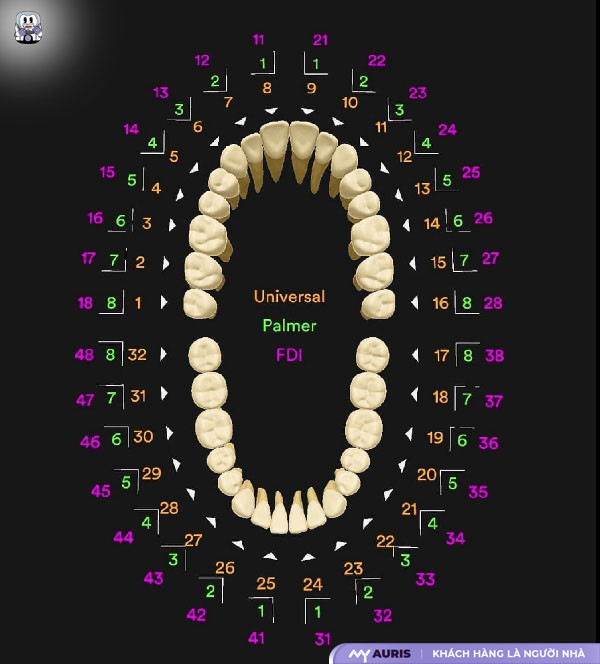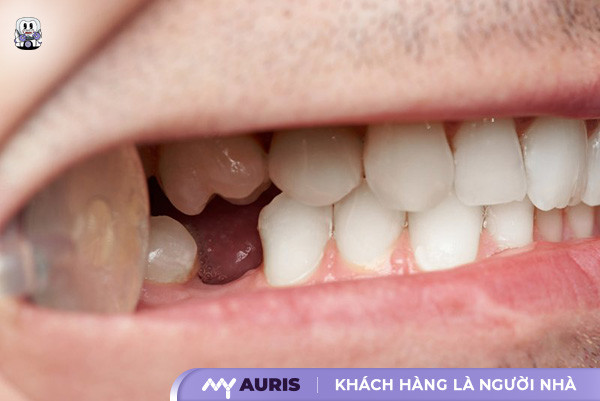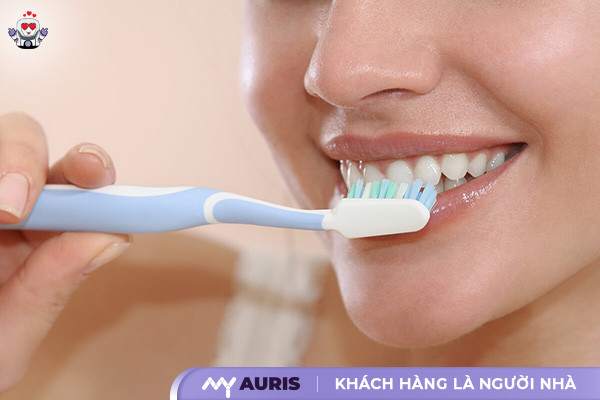Tooth number 6 is the permanent molar, grows only once in life and plays an important function in chewing and crushing food. So if you accidentally lose tooth number 6, can you get braces? In case of losing both teeth number 6, is braces solution feasible? Let’s find out in detail to make the best decision for your oral health.
Important characteristics of tooth number 6
Teeth Number 6 is one of the large molars that plays an important role in chewing function. This is a permanent tooth, grows only once and cannot be replaced if lost. Right from the moment of growth, tooth number 6 has a solid structure, helping to crush food from soft to hard. In particular, this tooth is linked to many nerves in the jawbone, so if lost, it will cause many negative effects on oral health, requiring timely remedial measures.
Tooth number 6 is large in size with strong roots and thick crowns. The system of ligaments and blood vessels around this tooth is also larger than other teeth, helping to ensure stability in the jaw. Due to its inner position, tooth number 6 does not appear when smiling. Structurally, lower molar number 6 usually has 2 roots, while upper molar number 6 has 3 roots, helping to increase the ability to withstand force when chewing.
Tooth number 6 has a large number of root canals, ranging from 3 to 5 root canals. This means that if the tooth becomes infected or damaged, the treatment process will be longer and more complicated. Therefore, taking care of tooth number 6 from an early age is essential to maintain chewing function and protect long-term oral health. If teeth are damaged or lost, appropriate replacement measures are needed to prevent consequences affecting bite and overall health.
Protecting tooth number 6 not only helps maintain chewing function but also makes an important contribution to the stability of the entire oral system.

Causes of loss of tooth number 6
Loss of tooth number 6 is a common condition in adults, caused by many different factors. According to statistics, about 20% of the population is congenitally missing at least one tooth, most commonly the second molars and upper lateral incisors. This is usually due to genetic factors, although in rare cases it can be genetica sign of a genetic disorder.
Besides genetic factors, dental problems such as gingivitis and tooth decay are the leading causes of this condition. Gingivitis is an early sign, showing an imbalance in oral care. If not treated early, it can progress to periodontitis, a serious infection that leads to tooth loss and aging of the jawbone.
In addition, tooth trauma due to head and face accidents is also a common cause of tooth number 6 being lost. Strong impact, direct impact on molars, leads to tooth fracture or loss before middle age.
You can prevent the causes of tooth loss number 6 with the following measures:
- Maintain proper oral hygiene habits: brush twice daily, floss and mouthwash.
- Regular dental check-ups: dental check-ups every 6 months to detect and treat dental problems early.
- Protect your teeth when playing sports: use mouth guards when playing sports with a high risk of collision.
- Proper nutrition: supplement calcium and vitamin D to maintain jaw bone health and strong teeth.

Effects of losing tooth number 6
Tooth loss not only affects aesthetics but also causes a series of serious oral health problems. When tooth number 6 is lost, the jawbone in that area is at risk of disappearing because it no longer receives force from chewing. This reduces bone density, causing the face to lose its natural fullness.
Complications due to loss of tooth number 6
- Jawbone resorption and sunken cheeks: When there is no longer the stimulating chewing force, the jawbone gradually disappears, leading to sunken cheeks, making the face look older.
- Affects chewing function: Tooth number 6 plays an important role in crushing food. When you lose teeth, you have to put chewing force on the other side, causing bite imbalance, jaw muscle fatigue and can lead to facial misalignment.
- Tooth misalignment and malocclusion: If not replaced promptly, adjacent teeth such as teeth No. 5 and No. 7 tend to tilt into the gap, causing malocclusion and affecting the entire jaw structure.
- Negative effects on overall health: Tooth loss can force you to eat soft or liquid foods, reduce the amount of nutrients absorbed, and affect the digestive system.
- Increased risk of temporomandibular arthritis (TMJ): When the remaining teeth are unbalanced in bearing the chewing force, jaw pain can appear, even causing chronic headaches.
Can I get braces if I lose tooth number 6?
Losing tooth number 6 can affect the ability to chew and chew and oral health. However, in some cases, braces can still be performed to correct this situation.
If you still have or are growing wisdom teeth (tooth number 8), braces can help pull teeth number 7 and number 8 to replace the position of tooth number 6. In the case of tooth number 8 being impacted, you can still consider braces but Need examination for specific assessment.
In case of not being able to get braces when tooth number 6 is missing
If there is no wisdom tooth Or if you have had your wisdom teeth removed but are missing tooth number 6, braces will not help. Dental implants will be the optimal solution to restore chewing function and ensure the stability of the jaw.
- If teeth number 7 and tooth number 8 in the same jaw are intact, the dentist can use orthodontic appliances to move these two teeth into the position of tooth number 6.
- After the braces process, tooth number 7 will take on the role of tooth number 6, and tooth number 8 will replace tooth number 7.
- In case tooth number 8 has not completely erupted or is impacted, the dentist will evaluate to come up with a suitable solution.

Popular braces method
- Braces: Uses a system of brackets and wires to create force to pull teeth to the correct position on the jaw. Braces can be metal or ceramic to ensure aesthetics.
- Invisalign clear braces: Modern method does not use braces, instead it is a transparent tray that helps move teeth slowly. Invisalign is highly aesthetic, easy to remove and convenient for eating and oral hygiene.
Notes when using braces to replace tooth number 6
- The process of pulling tooth number 7 into the position of tooth number 6 needs to be carefully calculated, especially because tooth number 7 has many roots and can withstand large chewing forces.
- If the tooth loss gap is too large, braces may not be 100% effective, then, implanting tooth number 6 may be a necessary solution.
Should tooth number 6 be extracted when using braces?
Tooth number 6 plays an important role in chewing function and maintaining tooth structure. So, is removing this tooth with braces really necessary? Let’s explore the future effects of this decision.
Tooth number 6 plays a key role in chewing and swallowing food. When lost, the chewing process is reduced effectively, creating pressure on the digestive system because the food is not thoroughly crushed. In the long term, this can cause digestive disorders and reduce the ability to absorb nutrients.
Losing tooth number 6 creates a gap between the teeth, making the teeth on both sides easily move, causing misalignment and malocclusion. This not only affects aesthetics but also reduces chewing function, causes pain and increases the risk of tooth enamel erosion.
Even though tooth number 6 is not in the front teeth group, losing this tooth can lead to gum recession, causing other teeth to move and cause misalignment. When smiling or talking, this reduces aesthetics and confidence.
Losing tooth number 6 over a long period of time leads to jaw bone loss. Without chewing force, the jaw bone will degenerate, gradually losing the conditions to maintain bone height and thickness. This makes the face appear sunken and older.
In cases where tooth number 6 should be extracted for braces
In During the braces process, doctors always prioritize preserving real teeth and prescribe tooth extraction when truly necessary. For tooth number 6, tooth extraction can be considered in the following cases:
Severe tooth decay: If tooth number 6 is severely decayed, has lost almost all tooth tissue and cannot be restored with fillings or porcelain crowns, the doctor will prescribe tooth extraction to ensure the process.Braces can go smoothly, avoiding affecting overall oral health.
Severely cracked or broken teeth: While eating, chewing hard foods can cause cracked or broken teeth. If the level of damage is too great to be restored by dental methods such as fillings or porcelain crowns, the doctor may recommend tooth extraction to avoid affecting the bite and orthodontic process.
Teeth growing in the wrong position, without chewing function: Tooth number 6 plays an important role in chewing and grinding food. However, if the teeth grow crookedly, point outside the jaw, or do not participate in the chewing process, the doctor may consider extracting the tooth to create reasonable space during the braces process.
Teeth with severe periodontitis: When tooth number 6 has severe periodontitis and cannot be treated conservatively, tooth extraction will help protect the teeth. surrounding teeth and support the braces process to achieve the highest efficiency. The doctor will prescribe tooth extraction to ensure that the braces process can go smoothly and safely.
Some notes when using braces to extract tooth number 6
During the braces process, removing tooth number 6 is a decision that needs careful consideration. Dentists often limit the indications for this tooth extraction, unless absolutely necessary. If you are in the group that needs to have it done, please note the following to ensure the best orthodontic results.

Proper oral hygiene
When wearing braces or braces, teeth hygiene becomes more important than ever. Proper dental care helps limit plaque, bacteria and protect oral health.
Necessary cleaning tools:
- Toothbrush: Choose a toothbrush with soft bristles and a small head to easily reach areas of the teeth that are difficult to clean.
- Interdental brush: Supports the removal of plaque between teeth and around braces, reducing the risk of gingivitis.
- Dental floss: Helps clean food stuck in between teeth, especially necessary for sparse teeth.
- Water flosser: Is the solutionEffective cleaning pressure, removing plaque that regular brushes cannot reach.

Comply with follow-up schedule
Extracting tooth number 6 creates space in the jaw, helping the teeth move faster. However, to ensure that the braces process goes on the right schedule, you need to have a follow-up visit on the schedule prescribed by the doctor.
At each follow-up visit, the doctor will adjust the traction so that the teeth move in the right direction. If you miss regular check-ups, teeth can move uncontrollably, prolonging treatment time and affecting the final results.
Proper diet
Close nutrition important role in the orthodontic process. After tooth extraction and braces installed, you may feel pain, affecting your ability to eat and drink. Therefore, it is necessary to prioritize soft, easy-to-chew foods such as:
- Porridge, soup, smoothie, yogurt
- Boiled vegetables, soft fruits
Limit hard, chewy foods such as hard candy, ice, nuts, and foods that are too hot or too cold to avoid damaging teeth and braces.
Choose a reputable dentist
To ensure the braces process is safe and highly effective, choosing a reputable dentist is a prerequisite. You should learn carefully about the performing doctor, the equipment at the clinic and previous customer reviews.
Criteria for choosing quality dentistry:
- Highly qualified, experienced doctor
- Advanced orthodontic technology
- Clear and transparent treatment process
- Committed to monitoring the results after treatment
But not all situations can apply the braces method to close the gap between tooth number 6. In some cases, if teeth number 7 and number 8 are completely missing or the tooth loss area is too large, accompanied by significant bone loss, thenBraces solutions may not bring optimal results. In that case, traditional restoration methods such as porcelain bridges or implants will be a more suitable choice, helping to ensure chewing function and long-term aesthetics.





